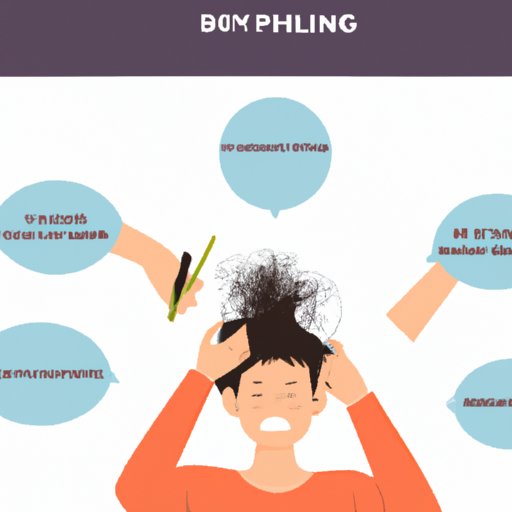Introduction
Hair pulling disorder, also known as trichotillomania, is a mental health condition characterized by the compulsive urge to pull out one’s own hair from anywhere on the body. It can be a difficult problem to manage and can have serious physical, emotional, and social consequences. If you or someone you know suffers from this condition, it is important to understand the problem and find ways to address it.
Seek Professional Help
The first step in managing hair pulling disorder is to seek professional help. There are several types of professionals who can provide support and guidance, including general practitioners, psychiatrists, psychologists, and counselors. Working with a professional can help you identify underlying issues that may be contributing to the problem and develop a personalized treatment plan.
In addition to providing valuable insight into the underlying causes of the issue, seeking professional help can also give you access to tools and techniques for managing your symptoms. For example, your doctor may recommend medications or suggest cognitive behavioral therapy, which can help you learn to recognize and change the thought patterns and behaviors that contribute to the problem.

Identify Triggers and Try to Avoid Them
It can be helpful to identify what triggers your hair pulling urges so you can try to avoid them. Common triggers include stress, boredom, anxiety, fatigue, and hunger. Once you have identified your triggers, you can work on avoiding them when possible.
For example, if stress is a trigger for you, you may want to practice relaxation techniques such as deep breathing, progressive muscle relaxation, or mindfulness meditation. Additionally, you can create a daily routine to help reduce stress levels and get enough rest. Taking breaks during the day, engaging in physical activity, and eating healthy meals can all also help reduce stress.

Incorporate Relaxation Techniques into Your Daily Routine
Relaxation techniques can be an effective way to manage hair pulling urges. Examples of relaxation techniques include deep breathing, progressive muscle relaxation, guided imagery, and yoga. Incorporating these techniques into your daily routine can help reduce stress and anxiety, which in turn can help reduce the frequency and intensity of hair pulling episodes.
When trying to incorporate relaxation techniques into your daily life, it is important to find activities that work best for you. Experiment with different techniques until you find something that helps you relax. You may also want to set aside time each day specifically for relaxation. This could mean taking a few minutes to practice deep breathing or spending 30 minutes doing a yoga class.
Keep Busy with Hobbies and Activities That Occupy Your Hands
Keeping busy with activities that occupy your hands can be an effective way to manage hair pulling urges. Examples of activities that can help distract you from pulling include knitting, drawing, playing an instrument, and playing sports. Finding activities that you enjoy can make it easier to stay focused and keep your mind off of your urges.
If you are having trouble finding activities that work for you, try talking to friends and family members about their hobbies or searching online for ideas. You may also want to consider joining a local club or organization where you can meet new people and explore different interests. The more options you have for activities, the easier it will be to stay occupied and avoid the temptation to pull your hair.

Distract Yourself When You Feel the Urge to Pull
When you feel the urge to pull your hair, it can be helpful to find ways to distract yourself. Ideas for distraction include listening to music, going for a walk, reading a book, or watching a movie. Doing something that engages your mind and takes your focus away from the urge to pull can be a powerful tool for managing your symptoms.
It can also be helpful to have a list of activities that you can do when feeling the urge to pull. Having a plan in place can make it easier to stay focused and take your mind off of the problem. Additionally, it can be beneficial to talk to a friend or family member when feeling the urge to pull. Talking to someone can help you gain perspective and provide an outlet for discussing your thoughts and feelings.
Consider Using Cognitive Behavioral Therapy
Cognitive behavioral therapy (CBT) is a type of psychotherapy that focuses on changing patterns of thinking and behavior. In the context of hair pulling disorder, CBT can help you become aware of negative thought patterns related to hair pulling and replace them with more positive and productive thoughts. Additionally, CBT can provide strategies for managing stress, developing coping skills, and resisting the urge to pull.
CBT can be done in individual or group sessions, and it can be done in person or online. Working with a trained therapist can help you develop the skills needed to manage your symptoms and make lasting changes. Additionally, there are numerous books and online resources available that can provide additional guidance for managing hair pulling disorder.
Conclusion
Hair pulling disorder can be a challenging problem to manage, but there are steps you can take to reduce the frequency and intensity of the urges. Seeking professional help, identifying triggers, incorporating relaxation techniques into your daily routine, keeping busy with activities that occupy your hands, distracting yourself when feeling the urge to pull, and considering cognitive behavioral therapy can all be useful strategies for managing hair pulling disorder.
If you or someone you know is struggling with this condition, it is important to reach out for help. With the right support and guidance, it is possible to make changes and improve your quality of life. Do not hesitate to speak to your doctor or a mental health professional if you need assistance.


